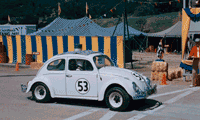
1996 Volkswagen Sedán Clásico “Open Air” Schuco - 45 038 7900 (diecast)
Published 06/17/22
In the early 50s, the Käfer was a huge commercial success. Consequently, Volkswagen’s (only) plant at Wolfsburg was at full capacity. To make matters worse, the Volkswagen Limousine was also gaining international demand. In 1955, the 1,000,000th unit rolled out of the Wolfsburg assembly line. With that, VW opened more factories in Europe, to fulfill local and international orders. And in 1957 they built their first plant outside of Europe, in Melbourne, Australia. Two years later, VW inaugurated their factory in São Paulo, Brazil. That was followed in 1962 by a plant in Xalostoc, Mexico, and another in Uitenhage, South Africa, in 1965. By 1963, VW produced 10,000,000 units. Slowly, however relentlessly, the people’s car gained the world. By the way, the 1,000,00th car? It was gold with bumpers lined with rhinestones – you can see it at Wolfsburg’s AutoStadt Museum.

In Mexico, the first “Vocho” arrived in 1954, as part of an exhibition. At the time, the Mexican automotive market was entirely supplied by American cars. To publicize the car, seven VW 1200 Sedans participated in the gruesome 1954 Carrera Panamericana. Though none won, all seven finished the race. Official importation of the car soon followed, and in 1962 VW opened an assembly plant in Xalostoc, State of Mexico. However, the Xalostoc plant was not keeping up with the demand. So, in 1965 VW inaugurated a new plant in Puebla, 130 km SE of Mexico City. On October 23, 1967, the first Sedan 1200 rolled off of the Puebla line, and in June of 1968 VW Mexico introduced a new 1493 cm³ engine. This new engine delivered 43 hp, a little better than the 40 hp of the 1200 engine.

In 1974 further modifications came – chiefly, a new 1.6 engine. This new boxer-4 displaced 1584 cm³, producing 53 hp and allowing a top speed of 135 km/h. The Vocho also received enlarged front fenders, new front turn signals and larger round tail lights with amber turn signals. These bigger tail lights were nicknamed “elephant foot lights”. In 1977 the front turn signals migrated to the front bumper, like on the post-1975 European Beetles. With the end of the German production line, VW Mexico exported the Vocho to Europe. However, these export models all had the older 1200 engine. VW continued evolving the Vocho piecemeal, and in 1986 it received the larger rear window from the 1972 German Käfer. In 1991, by governmental disposition, it received a catalytic converter. However, it kept its carburetor, electrical system and the old ignition system.

In 1995, according to VW Mexico, the Vocho received 87 improvements. Among other items, it got new front disc brakes and an alternator replaced the generator. In terms of aesthetics, now the door handles, stirrup moldings and side mirrors were all matte black. Moreover, bumpers and headlight moldings came in the same color of the car. At the time, VW officially offered two versions of the car, the Sedán City and Sedán Clásico. The Clásico was slightly upscale, with black vinyl upholstery. However, some Sedáns received a modification right after leaving the factory: a sunroof.

The sunroof was a modification performed on some of the cars after they left the Puebla factory. However, installation occurred before the sale; therefore it was a VW-approved modification. If a customer wanted, he could have his brand new VW Sedán with the “Open Air” option. Made of vinyl, an electric motor opened and closed it. Opening the sunroof was slow and cranky, and was not exactly a smooth operation. Nonetheless, it was a very popular option among buyers. VW Mexico produced the Vocho, basically unchanged, until 2003. In June 2003 VW introduced the Volkswagen Sedán Última Edición, a limited edition of 3000 cars. Of these, 2,999 went to VW dealers across Mexico and the last one went to the AutoMuseum Volkswagen, in Wolfsburg. And that was the last hoorah of the classic Beetle…😥


Schuco released this little gem in 2016, and supposedly it is a limited edition of 1000 models. Mine is in “Bright White”, yet Schuco also offers a version in “Classic Green Pearl”. Though the white one is fairly easy to find, I never saw the green one offered on eBay. Once again Schuco delivered a beauty of a model, just as gorgeous as my Käfer 1100. And again, Schuco falls short on correctly designating the model 🙄. I now know it’s a Mexican Vocho (or more correctly, a 1996 VW Sedán Clásico) because I did some research. Yet, according to Schuco, it is just a “VW Käfer”. If I can find the real name, I bet they can also. Deficient naming aside, the model is a duesy, so I will cut them some slack 😋.
And here we start W-143 Beetlemania. Stay tuned, more beetles will show up!


